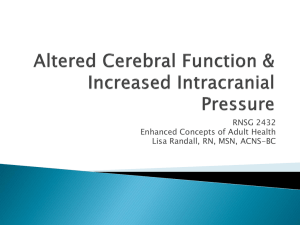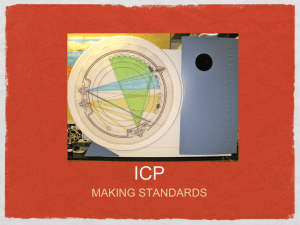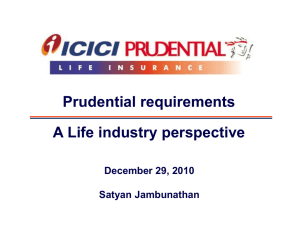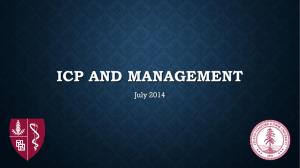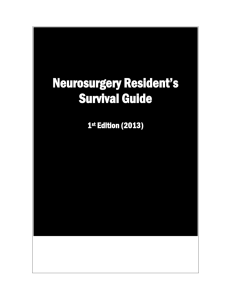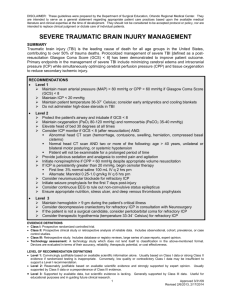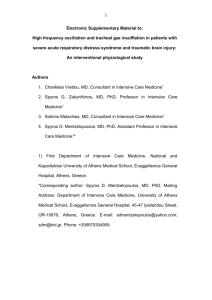Response of Brain Tissue to Trauma
advertisement
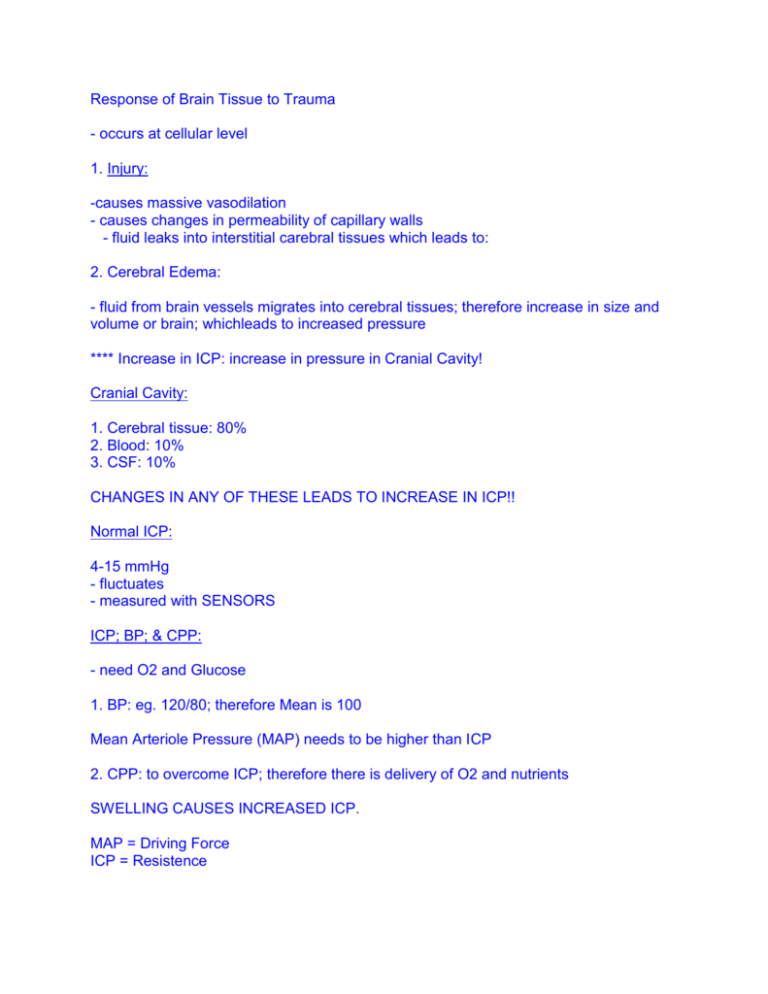
Response of Brain Tissue to Trauma - occurs at cellular level 1. Injury: -causes massive vasodilation - causes changes in permeability of capillary walls - fluid leaks into interstitial carebral tissues which leads to: 2. Cerebral Edema: - fluid from brain vessels migrates into cerebral tissues; therefore increase in size and volume or brain; whichleads to increased pressure **** Increase in ICP: increase in pressure in Cranial Cavity! Cranial Cavity: 1. Cerebral tissue: 80% 2. Blood: 10% 3. CSF: 10% CHANGES IN ANY OF THESE LEADS TO INCREASE IN ICP!! Normal ICP: 4-15 mmHg - fluctuates - measured with SENSORS ICP; BP; & CPP: - need O2 and Glucose 1. BP: eg. 120/80; therefore Mean is 100 Mean Arteriole Pressure (MAP) needs to be higher than ICP 2. CPP: to overcome ICP; therefore there is delivery of O2 and nutrients SWELLING CAUSES INCREASED ICP. MAP = Driving Force ICP = Resistence CPP = MAP - ICP = 100 mmHg - 15 mmHg; This is a NORMAL reading - therefore the CPP that is NORMAL is: 85 mmHg Regulatory Mechanisms Protect brain from increases in ICP by maintaining CPP 1. Pressure Autoregulation: Maintains CPP: eg. EXERCISE increases BP which leads to Vasoconstriction eg. ORTOSTATIC HYPERTENSION decreases BP which leads to Vasodilation Problems: 1. Systolic BP increases >150 mmHg which leads to zero AUTOREGULATION which leads to H/A (Tension) 2. Increased ICP > 30-33 mmHg leads to zero AUTOREGULATION; therefore decreased blood flow to brain; therefore increased ICP from cerebral edema; which leads to poor perfusion and ultimately brain damage/death 2. Metabolic Regulation Cerebral blood vessels sensitive to: i) PCO2 ii) PO2 iii) Temperature Vasodilation occurs when: i) oxygenation poor (decreased PO2) ii) Resps fail (increased PCO2) iii) Fever iv) Acidosis WHY??? Dilation! NSG: Keep: PCO2 low; PO2 high; Temp normal or low WHAT HAPPENS WHEN ICP IS SUSTAINED? 1. Body compensates initially (if ICP is at 20 mmHg > 10 minutes) 2. CSF production decreases; then CSF absorption increases 3. Decreased BS to brain leads to decreased volume 4. Babies: Skull expands 5. Compression of brain tissue 6. CUSHING'S TRIAD (opposite of shock) - decreased HR and RR; increased BP THEREFORE INCREASED ICP WHICH LEADS TO DECOMPENSATION!!!! Steps of Decompensation: 1. Increased ICP 2. Decreased cerebral blood flow 3. Brain ischemia 4. Cerebral vasodilation: increased CO@, decreased O2 5. Cerebral edema 6. Increased ICP+++ 7. Brain tissue compressed 8. Blood vessels compressed which leads to more increased ICP 9. Brain death Nursing Care Increased ICP 1. Assessment: SUBTLE changes 2. LOC: increased agitation, restlessness, personality changes decreased alertness: WHY? Cerebral hypoxia! 3. Pupil reaction: unequal (because increased ICP) 4. Motor strength and function: First: Spontaneous Second: if not alert --- test response to stimuli (eg. tickle; increase pressure; NO PAINFUL STIMULI!!! 5. Vital signs: Problems with increased ICP before changes in VS: Increased ICP = decreased HR, increased BP, wide pulse pressure 6. Vomiting/H/A: - vomiting: pressure on vomiting centre - H/A: increased pressure on pain sensitive arterioles 7. Suctioning: BE CAREFUL 8. Increase HOB 9. Positioning 10. Pain control 11. Turn slowly 12. Reassure 13. Careful discussion 14. Therapeutic touch



